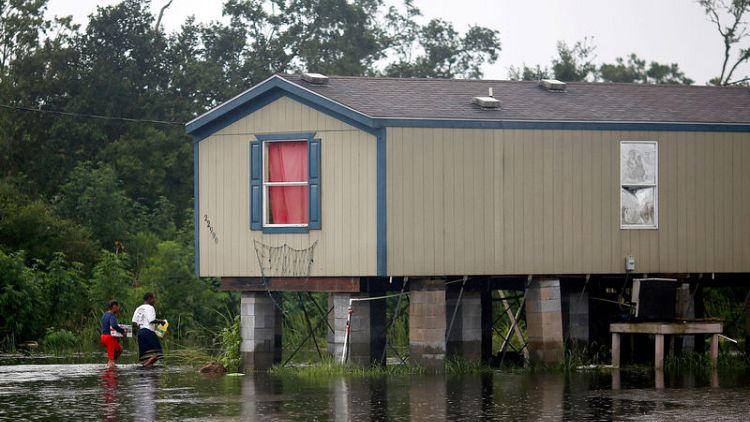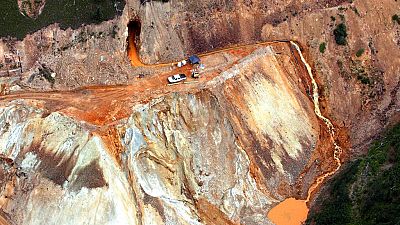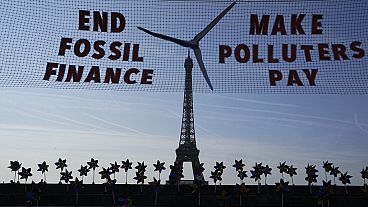By Kate Duguid
NEW YORK (Reuters) - David Burt helped two of the protagonists of Michael Lewis' book The Big Short bet against the U.S. mortgage market in the run-up to the 2008 financial crisis. Now he's betting against the market again, but this time, the risk is not from underwater subprime mortgages, it's from homes sinking under water.
As he did then, Burt has given up his full-time job to make that bet. He left his role as a portfolio manager at the $1 trillion (£813.80 billion) Wellington Management last year to start an investment firm, DeltaTerra Capital, which aims to help clients manage climate risk, and, where possible, take advantage of ways the market has not yet priced in that risk. His first investment strategy is targeting residential mortgage-backed securities, or RMBS, with exposure to climate hot spots like Texas and Florida.
In doing so, Burt is joining the ranks of a small number of investors who have become worried that climate risk is underpriced in these securities, which are pools of home loans sold to investors.
"The market's failure to integrate climate science with investment analysis has created a mispricing phenomenon that is possibly larger than the mortgage credit bubble of the mid-2000s," Burt wrote in a presentation to prospective clients.
Most mainstream investors remain sceptical of the impact of climate change on their portfolios or argue that they are diversified enough not to have to worry about the risks.
Burt and at least three other investors said in interviews with Reuters that they think the risk is real. They argue that a growing body of academic research and data shows that hurricanes, flooding and other disasters pose a far larger threat than is currently being priced into mortgage securities.
"I don't think you need any new climate effects to come to draw these conclusions. The ones I see happening right now, I just need to get a little unlucky with them and I'm in trouble," said Thomas Graff, head of fixed income at Brown Advisory. Graff abandoned a riskier type of RMBS after Hurricane Harvey hit Houston in 2017.
FLOOD MAPS
Climate researchers and investors say a key culprit for the mispriced risk in the U.S. mortgage market is outdated flood maps drawn by the federal government.
These maps determine the premiums on government-sponsored home insurance policies. Due to budget cuts, more than three-quarters of the maps have not been updated in at least five years, according to First Street Foundation, an organization that is developing a publicly accessible database of up-to-date flood risk information.
Outdated maps mean far fewer people are required to have flood insurance than are at risk, the investors and researchers say. A University of Bristol estimate put the actual figure at around three times the 13 million Americans currently living in designated flood zones.
The gaps are evident: About 70% of all damages to homes that were flooded during Harvey were not covered by insurance, according to CoreLogic.
The federal government provides most flood insurance in the United States and the gaps mean the risk is not properly priced. The cost for an average policy in low-risk Green Bay, Wisconsin, for example, is three times that in Gulfport, Mississippi, a town devastated by Hurricane Katrina, according to Burt.
The Federal Emergency Management Agency has said it aims to fix some of these problems with a major risk re-rating on Oct. 1, 2020.
Burt’s bet is that the move will result in significant cost increases. That in turn will lead to home price declines and mortgage losses, which would increase volatility in RMBS prices.
He expects a correction beginning in the next 6-18 months.
"The bet I'm making is that many regional markets will experience large price declines in response to increasing costs related to the geography-specific risks," Burt said.
CLIMATE LOSSES
There are many risks to Burt’s thesis. In the past few years, RMBS prices have recovered after disasters such as Harvey. The federal government has stepped in with aid when losses were not covered by flood insurance.
David Goodson, head of securitised fixed income and senior portfolio manager at Voya Investment Management, said he does not dismiss RMBS deals that have significant concentration in flood hot spots like Miami or Houston.
"While there are more vulnerable population centres that are at greater risk, I think it would be imprudent to out-of-hand dismiss deals that have a concentration in a particular" area, he said.
Burt thinks the mainstream view will be proven wrong. Some of the conditions that allowed prices to recover after Harvey, such as redevelopers bailing out homeowners, could disappear if there is an economic downturn.
Investors also have been taking on more risk. Some RMBS issued by Freddie Mac and Fannie Mae since 2017, called credit risk transfer (CRT) deals, move the risk of default to the investors. In traditional agency RMBS, Fannie and Freddie cover those losses.
Between 2% and 4% of the loans in outstanding CRT deals were located in Houston and other areas badly hit by Hurricane Harvey, according to Bank of America. While prices of these securities recovered, investors in lower tranches of the capital structure in some deals took losses they did not recover.
This is because the most junior tranches have little or no protection. The lowest tranche of the most recent Freddie Mac CRT will start losing principal if mortgage pool losses exceed 0.1%.
"It has been building up," Burt said, "and so when the correction comes, it will probably come in a more meaningful way than people are expecting."
(Reporting by Kate Duguid; Editing by Paritosh Bansal and Dan Grebler)



